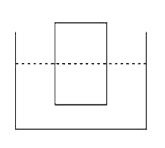A cylinder isotropic solid of coefficient of thermal expansion α and density ρ (at STP) floats in a liquid of coefficient of volume expansion γ and density d (at STP) as shown in the diagram.

The correct Answer is:A-P;B-R;C-SD-Q
(A) Buoyant force = Mg = constant =V⊂=Mgρlg . Volume of displace fluid = constant ∴ density of fluid must be constant.
(B) (Vsolid−Vsub)=constant⇒(Vsolid−Msolidρliquid)=constantV×3α×ΔT=MγΔTd⇒3αdρ
(C ) Ahindlquid=A(hin+hout)ρsolid=M(mass of soild)
hout=−MAρsoild,hin=MAρsoild−MAdliquid=constant
M(1+3αΔT)A(1+2αΔT)ρ−M(1+γΔT)A(1+2αΔT)d=MAρ−MAd,γ=2α+αdρ
(D) Ahindliquidg= Buoyant force = constant = Mg
A0(1+2αΔT)hin d1+γΔTconstant,hin=MA0d(1+(γ−2α)ΔT)γ=2α
Similar Questions
A cube of coefficient of liear expansion αs is floating in a bath containing a liquid of coefficient of volume expansion γL. When the temperature is raised by ΔT, the depth upto which the cube is submerged in the liquid remains the same. Find the relation between αs and γL showing all the steps.
View SolutionA cube of coefficient of linear expansion α is floating in a bath containing a liquid of coefficient of volume expansion γl. When the temperature is raised by ΔT, the depth upto which the cube is submerged in the liquid remains the same. Find relation between α and γl
View Solution
Knowledge Check
A solid with coefficient of linear expansion aplha just floats in a liquid whose coefficient of volume expansion is γ . If the system is heated, the solid will
Asink in all casesBcontinue to float in all casesCsink if γ>3αDsink ifγ<3αCoefficient of linear expansion α an coefficient of volume expansioγ of solid are related as
Aγ=3αBα=3γCγ=2αDα=γOn heating a liquid of coefficient of cubical expansion γ in a container having coefficient of linear expansion γ/3. The level of liquid in the container will
AriseBfallCwill remain almost stationaryDit is difficult to say
Can we related the thermal coefficient of linear expansion, α, to the thermal coefficient of volume expansion?
View SolutionCan we related the thermal coefficient of linear expansion, α, to the thermal coefficient of volume expansion?
View SolutionA liquid with coefficient of volume expansion γ is filled in a container of a material having coefficient of linear expansion α . If the liquid overflows on heating, then
View SolutionA liquid with coefficient of volume expansion γ is filled in a container of a material having coefficient of linear expansion α . If the liquid overflows on heating, then
View SolutionA liquid with coefficient of volume expansion γ is filled in a container of a material having coefficient of linear expansion α . If the liquid overflows on heating, then
View Solution
